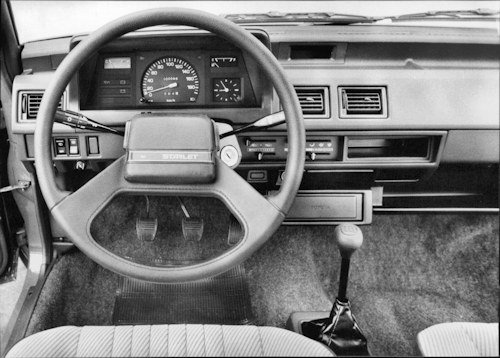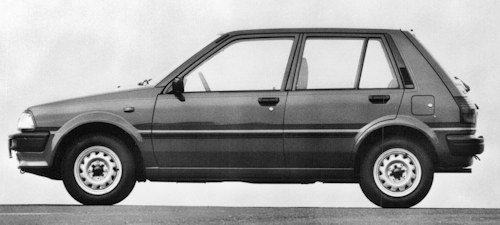Toyota Starlet 3rd Generation EP7#/NP7
 | |
Production: | 1984 to 1989 |
Class: | Motor car |
Body versions: | hatchback van |
Engines: | Gasoline: 1.0-1.3 liters (40-75 kW) |
Length: | 3700 mm |
Width: | 1590 mm |
Height: | 1380 mm |
Wheelbase: | 2300 mm |
Curb weight: | 740 kg |
The third generation of the Toyota Starlet from the 1980s was built from 1984 to 1989 model name EP7/NP70.
History
Based on the results of the Tercel / Corsa, the drive system was changed to the horizontal front-wheel drive the P7 was a newly designed model with transverse engine and front-wheel drive as a car and van in some markets (EP76V) also existed, but unlike its predecessor, it had the same body as the 3-door hatchback passenger model.
The front suspension is a common MacPherson strut, but the lower arm has been redesigned from the previous I-shaped lower arm to the same L-shaped lower arm as the E8# Corolla/Sprinter to match the FF layout, and the rear suspension. is a simpler cheaper to make trailing twist beam (axle beam) with a configuration that minimizes the number of moving parts and parts.
There is a 1.0L displacement 1E type for European specifications. The deluxe was made-to-order and was equipped with a lean-burn engine low fuel consumption special "partial lean system specification” (model code EP70, engine code 1E, 40 kW) or with 1.3 l (model code EP71, engine code 2E, 55 kW) and is equipped with a 2E type in-line 4-cylinder SOHC 12-valve that uses a cross-flow bathtub combustion chamber (2E - ELU type is installed on the 3-door Ri and 3-door/5-door Si)
In Europe he was the last model with carburettor preparation (2-stage carburettor 1.0 litre, constant pressure carburettor at 1.3-liter engine). As of 1986, starlets now offered in Switzerland had a catalyst because of the stricter emission standards. In the last model year, the EP71 was also offered in other European countries with a combination of constant pressure carburettor and regulated catalyst.
- PERFORMANCE (1.3L carb)
power-weight ratio: 20.3 lb/hp (27.6 lb/kW), 9.2 kg/hp (12.5 kg/ kW)
max power (JIS): 76 hp (56 kW) at 6,000 rpm
max torque (JIS): 78 1b ft, 10.7 kg m (105 Nm) at 4,400 rpm
max engine rpm: 6,400
Power per litre: 58.7 hp/l, (43.2 kW/l)
fuel consumption: 65.6 m/imp gal, 54.7 m/US gal, 4.3 1 x 100 km on Japanese emission test cycle. - PERFORMANCE: 1.3L fuel injection
max power (JIS): 93 hp (68 kW) at 6,200 rpm
max torque (JIS): 82 1b ft, 11.3 kg m (111 Nm) at 5,000 rpm
max engine rpm: 6,600
71.8 hp/l (52.8 kW/l)
power-weight ratio: Si 17.3 lb/hp (23.5 lb/kW), 7.8 kg/hp (10.6 kg/kW)
fuel consumption: 47.8 m/imp gal, 39.8 m/US gal, 5.9 1 x 100 km on Japanese emission test cycle.
The Starlet P7 was also available as Diesel (model code NP70, 40 kW) with 1.5 l prechamber diesel engine, engine code 1N the 1N type of 1.5L diesel engine was added for the first time through Publica and Starlet, and the model’s name was changed to NP70
In addition to the European versions such as the DX (replaced by the XL) and the S as a sporty variant, there was a turbo-S version (engine code 2E-TELU) especially for the Japanese market. This was equipped with a turbocharged 1.3-liter engine with gasoline injection. There was a grade for motor sports called Ri (naturally aspirated) Turbo R. Compared to the original sports grade Si Turbo S, comfort equipment such as unpainted bumpers and commercial grade interiors were removed, making it easier to modify to a competition vehicle. It was a popular model that succeeded the KP models and entered a wide range of competitions.

The 3-speed full automatic transmission was also available in many grades in line with the times, but the Ri-Si Limited, the cheapest passenger grade STD, and the van CD-L were not initially available. The 4-speed manual is set to the 2E's newly developed "new V-type carburettor" car. In 1987
Unlike the other series, the P7 offered in Europe was not revised during the entire production period. Only towards the end of production were some special models offered. Options in some markets such as air conditioner and coloured bumpers was often sold on a limited basis.
TOYOTA Starlet range
Standard 2+1 -dr Sedan
DX 2+1 -dr Sedan
DX-A 2+1-dr Sedan
XL 2+1 -dr Sedan
XL 4+1 -dr Sedan
XL Lisse 2+1 -dr Sedan
XL Lisse 4+1 -dr Sedan
SE 4+1 -dr Sedan
Ri 2+1 -dr Sedan
Si 2+1 -dr Sedan
Si Limited 2+1 -dr Sedan

Rating
Technical
-
Toyota Starlet 3rd gen Technical details and specifications (1984-1989)
1.0L Engine
No. of cylinders 4/OHC
Capacity 999cc
Compression ratio 9,0:1
Firing order 1-3-4-2
Suitable for unleaded petrol Yes
Minimum octane rating 91 RON
Fuel system Make Aisan Type 21100-10050 Carb
Diagnostic socket No
Ignition coil Make Nippon Denso Type 90919
Distributor Make Denso No. 10020
Fuel system delivery pressure 0,2-0,3 bar
Oil pressure 2,5-5,0 bar @ 3000rpm
Thermostat opens 80-84°C
Starter motor Make Denso 12V 0,8 kW
Maximum cranking amps 122-149 A
Alternator Make Nippon Denso
Regulated voltage 13,5-15,1VENGINE:1.3L
(Carb)
Location front
4 stroke; 4 cylindersin line
79 cu in, 1,295 cc (3.05 x 2.87 in, 77.4 x 73 mm)
compression ratio: 10: 1
1 V -type variable Venturi downdraught single barrel carburettor
fuel feed: mechanical pump(fuel injection)
compression ratio: 9.5:1
Bosch D-Jetronic electronic fuel injection
fuel feed: electric pump.cast iron block, light alloy head
5 crankshaft bearings
valves: overhead, push-rods and rockers
camshafts: 1, overhead
lubrication: rotary pump, full flow filter
6 imp pt, 7.2 US pt, 3.4 1
emission control with 3-way catalyst
secondary air induction and exhaust gas recirculation
water-cooled, 8.1 imp pts 9.7 US pt, 4.6 1.
TRANSMISSION
driving wheels: front
clutch: single dry plate (diaphragm)
gearbox: mechanical; gears: 4 or 5
fully synchronized
gear lever location: central
4 speed ratios: 1st 3.545, 2nd 1.904, 3rd 1.233, 4th 0.885, rev 3.095
5 speed 1st 3.545, 2nd 1.904, 3rd 1.310, 4th 0.969,5th 0.815, rev 3.520
(option) automatic transmission, hydraulic torque converter and planetary gears
3 ratios (1st 2.810, 2nd 1.549, 3rd 1, rev 2.296)
final drive: helical spur gears
axle ratio: 4 speed 3.095 axle ratio: 5 speed 3.526 axle ratio: Auto 3.333
width of rims: 4"
tyres: 145 SR x 13. or 135/80 R x 13.
CHASSIS
type integral
front suspension: independent, by McPherson, lower arms, coil springs/telescopic dampers rigid axle, coil springs/telescopic damper struts,
rear: Panhard rod, lower trailing radius arms, anti-roll bar.
(sport RI SI) front anti-roll bar.STEERING
rack-and-pinion
turns lock to lock: 3.60.
SE and XL Lisse servo turns lock to lock: 3.10.
turning circle: 26.2 ft, 8 mBRAKES
front disc, rear drum, servo
lining area: front 19.2 sq in, 124 sq cm
lining area: rear 26.6 sq in, 172 sq cm
lining area: total 45.8 sq in, 296 sq cm.ELECTRICAL EQUIPMENT
12 V
28 Ah battery
45 A alternator
Denso distributorDIMENSIONS AND WEIGHT
wheel base: 90.55 in, 230 cm
tracks: 54.33 in, 138 cm front, 52.75 in, 134 cm rear
length: 145.66 in, 370 cm
width: 62.59 in, 159 cm
height: 54.33 in, 138 cm
ground clearance: 6.10 in, 15.5 cm
weight:
DX-A Sedan 1,543 1b, 700 kg
XL 2+1-dr Sedan 1,565 1b, 710 kg
XL 4+1-dr and XL Lisse 2+1 -dr sedans 1,587 1b, 720 kg
XL Lisse 4+1-dr Sedan 1,609 1b, 730 kg
SE Sedan 1,632 1b, 740 kg.
Ri Sedan 1,587 1b, 720 kg
Si Sedan 1,609 1b, 730 kg
Si Limited Sedan 1,632 1b, 740 kg.
weight distribution: 64% front, 36% rear© Motor car History
-
Toyota Starlet Maintenance and Service Guide 3rd gen (1984-1989)
Manual gearbox oil grade 75W-90W SAE
Manual gearbox 4/5 speed 2,4 litres
Automatic transmission fluid Type Dexron II
Automatic transmission 2,2 litres
Road wheels Tighten 103 Nm
Parking brake travel No. of notches 7-9fuel tank: 8.8 imp gal, 10.5 US gal, 40 1.
carrying capacity: 882 1b, 400 kg1.0L Engine
Spark plugs Original equipment NGK Type BPR6EY
Spark plugs Electrode gap 0,8-1,1 mm
Spark plugs Tighten 18 Nm
Spark plugs Make Bosch Type WR7DC
Spark plugs Make Champion Type RN9YCC4
Distributor Contact breaker gap 0,45 mm
Distributor Dwell angle 46-58° (51-64%)
Valve clearance -INLET 0,20mm check hot
Valve clearance -EXHAUST 0,20mm check hot
Engine oil grade - normal/moderate climate 10W/30SAE or 10W/40SAE
Engine oil grade - cold climate 5W/30 SAE
Engine oil grade - hot climate 20W/40 SAE
Engine oil change with filter 3.2 litres
Sump oil drain bolt Tighten 25 Nm
Cooling system 4,6 litresTightening torques 1.0L
Cylinder head Tightening torques
Renew bolts No
Stage 1 Tighten 29 Nm
Stage 2 Tighten 49 Nm
Stage 3 Tighten 90°© Motor car History



